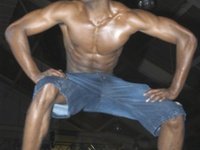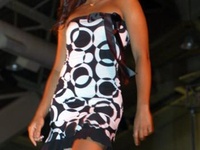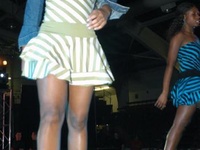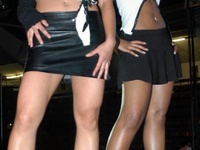As the bass beat of the walk-walk-walk-to-the-rhythm melody slinked throughout the crowd, revolving lights sparred with the continually transforming graphics on the video screen in eclectic tandem. An intoxicating dose of adrenaline and energy pulsed back and forth between the audience and the impossibly gorgeous figures onstage. On the evening of Friday, April 23, the only constant was the nostalgia-stimulant hip-hop roaring from the speakers, as the audience journeyed through four decades of pop culture fashion at Eleganza: Harvard’s annual spectacle of style.
There was not a seam to be seen in the diverse collection on the runway, nor any misstep in the execution of the multimedia display encompassing the 40-foot catwalk specifically designed for the production. The show’s organizers, student theater group BlackCAST, bypassed the typical runway venues in favor of a surround-sound multi-sensory experience of movement, expression and talent, creating what one crew member described as “a virtual playground.”
“Look, this is real, this is Harvard’s take on pop culture,” says the show’s creative director Jonathan R. Ardrey ’05. There are only a few hectic hours before Bright Hockey Center opens for the largest Eleganza production yet, and both he and executive producer Derek R. Melvin ’05 take a breather to reflect on their experience before dashing back down into the rink to survey the show’s sequencing.
“I watched Eleganza last year in Lowell Lecture Hall, and it was full, 400 people. Tonight, we have 1100 tickets sold out in the hockey rink,” says Melvin. “We wanted to bring it to another level, we wanted to push the envelope as far as it could go.” The push for a larger event was threefold, explains Melvin: more recognition for BlackCAST, lending a voice to talent that often goes unheard and just having fun.
“So many things here reach a specific audience,” Melvin says. “You have the theater for some people, classical concerts for others and cultural student groups that do their own thing, but this brings everybody together.”
As the show’s executive producer and creative director, respectively, Melvin and Ardrey are finally realizing a project eight months in production, forged from the collaborative vision of members of BlackCAST, a student staff, models, and professional clothing manufacturers. Originally begun 10 years ago, Eleganza has in recent years been building a reputation for its mélange of runway and theatrical performance. By far, this has been the most elaborate show yet, and model Sarah E. Johnson ’06, who performed in last year’s show, says there is a tangible difference.
“We were in a room packed with friends and it was more comfortable, because you knew everyone,” says Johnson. “But now, it’s less casual—you’re in front of 1300 people with a Jumbotron screen behind you.” Borrowed from Women In Color’s “Haute” show last semester, the video screen, coupled with computer graphics and sequenced sound, magnified the scope of the production tremendously. Although adding to the show’s high-stakes atmosphere, the visuals allowed for a look that previous producers could only dream of.
“One of the goals for this year’s show was to develop a unified aesthetic within a creative framework—one that would allow different media to be integrated into a fresh and exciting event,” says Ardrey. Deriving a more literal interpretation by dubbing this year’s theme, “Night at the Movies,” the show paid homage to the smooth synthesis of cinema with four separate themes: “Classic Hollywood,” “Blaxploitation,” “Boogie Nights,” and “80s Dance.”
Cinematic Extravagance
Eleganza’s program instructs the viewer to “watch as color and independence, originality and attitude come to dominate the red carpet.” The lights darken, a low rhythm reverberates and posed silhouettes signal the beginning of a two-hour flashback to icons of film culture, seeking to carry out the program’s promise.
The first sequence, “Classic Hollywood,” introduced an eclecticism borne of period-specific fashion and anachronistic music that was to run throughout the remainder of the show. Elegantly clad couples in dresses and suits reminiscent of 50s-era film noir strutted to the amplified beats of Method Man and Q-Tip, the crisp purity of the lights effectively evoking what the program called the “simple, clean and classic” characteristic of Hollywood’s early films.
In contrast with more routine runway shows that incorporate techno, lounge or jazz music at different points in the show, Eleganza’s musical range was strictly limited to straight hip-hop. The result was occasionally jarring, particularly at one point in “Hollywood,” when models paying homage to cinematic couplings of the 50s strutted to the R&B groove of Next’s “Wifey.”
The prevailing force of modern sensibility was also brought home with a kiss between models Nathalie Miller ’04 and Andrea H. Li ’04 a la Madonna and Britney Spears, which sent men and women alike to their feet and cameras flashing. Student dance company Expressions followed suit with a contemporary choreographed performance set to NERD’s fused rock-hop, featuring women in black cocktail dresses alongside men in suspenders and newsboy hats.
Pretenses of demure fashion established by “Hollywood” were quickly abandoned as the subsequent “Blaxploitation” theme evoked the sex appeal of the strong black male and female icons prevalent in popular 60s movies of the genre, such as Shaft and Foxy Brown. Revealing pieces from Wilson’s Leather, Planet Aid and Oona’s swayed and shimmered on bodies pulsating to the rhythm of “Sex Machine” and “Bad Mamma Jamma.”
The designers gave a nod to pimp fashion, an archetype of blaxploitation, in a sequence with bare-chested men reveling in the adulation of mini-skirted vixens. The segment’s tone was slightly marred by the off-putting notion that a production conscientiously pushing for racial diversity did little to challenge the film industry’s manipulative portrayal of African-Americans in the 1960s.


















